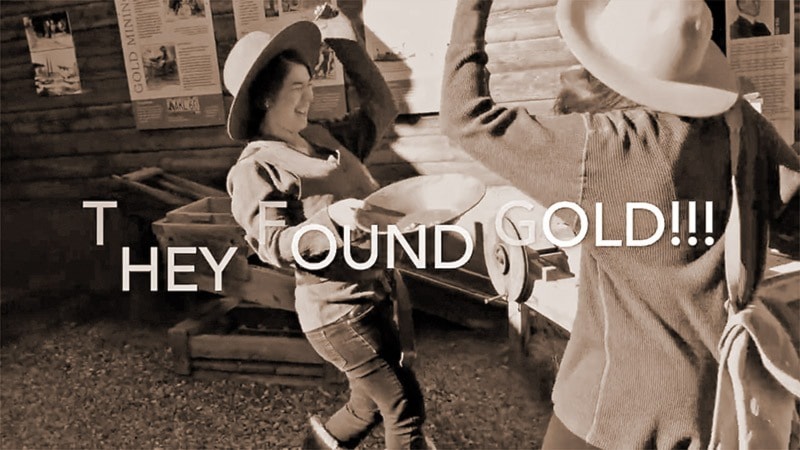There’s not a lot left of Canyon City.
The remains of an old horse tramway, some depressions in the ground where buildings used to sit, and a few piles of old, rusted tin cans are some of the only indications that a thriving Gold Rush community once sat near the head of Miles Canyon, just south of present-day Whitehorse.
Twelve-year-old Sarah Krause had never heard of Canyon City until her former teacher at Golden Horn Elementary School, Michelle Beaulieu, gave her Grade 7 students a history assignment this spring. They were to put together videos about different elements of Yukon history, complete with dramatic re-enactments.
The students’ videos were submitted to the nation-wide Young Citizens program, where they were reviewed by a panel of judges. And in August, Sarah and one of her classmates, Kasi Kafka-Kotelko, were selected to attend the Canada’s History Youth Forum in November, along with two students from every province and territory.
“I was actually really surprised… and happy, of course,” Sarah said of the moment when she got the news. “I’ve never been to Ottawa, so it’ll be really fun there.”
Sarah said she chose to make her video about Canyon City because it was a big part of the Klondike Gold Rush, even though she hadn’t known much about it.
“I didn’t really know that that was a huge spot that people would stop at before they would go gold panning,” she said.
Her video gives a brief synopsis of Canyon City’s history, from the earliest evidence of First Nation people at the site dating back about 2,500 years to its short-lived heyday as a stopping point for would-be gold miners on their way up the Yukon River to the Klondike in 1898.
At its peak, Canyon City was home to a hotel, a saloon, a restaurant, a store and a police detachment. A tramway was built from the townsite as a detour around the Whitehorse Rapids, but hundreds of boats were lost in the rapids all the same, in the mad rush toward Dawson.
But like so many other Gold Rush settlements, Canyon City was gone as quickly as it appeared.
“Although it thrived for a short time, by the 1900s, the White Pass railway was completed to Whitehorse and Canyon City had lost its reason for existence,” Sarah narrates in her video.
The video includes re-enactments of life in the community filmed by Sarah and her classmates at the MacBride Museum in Whitehorse, interspersed with old photos of the settlement.
“I think the hardest part was trying to match the (narration) with the photos,” Sarah said. “There weren’t that many photos online.”
In her video, 13-year-old Kasi focused on the Klondike Gold Rush itself and the founding of Dawson City. She describes how Skookum Jim, George Carmack and Dawson Charlie found gold in Bonanza Creek in 1896, and how some of the stampeders who arrived later became store owners in Dawson when they realized they were too late to make their fortunes in gold.
She goes on to explain how dredges were used for industrial gold mining around Dawson, starting in the early 1900s and ending about 60 years later.
Kasi also included several re-enactments in her video, including a memorable scene in which a Dawson couple trades a dog for a string of pearls in a local store. She even applied an old-timey, black-and-white filter for some added effect. She said the scene was mostly improvised.
Kasi hiked the Chilkoot Trail with her class last year, following in the footsteps of the Gold Rush stampeders. She said it was interesting to learn more about the Gold Rush for her video project, and to think about the conditions people had to deal with back in 1898, and all the supplies they had to carry with them.
“Reflecting back on it, it’s kind of crazy how they had to trudge through all the snow,” she said. “It’s just insane to think about.”
Neither Sarah nor Kasi have been to Ottawa before, and both said they’re excited to visit the city in November.
Joel Ralph, director of programs with Canada’s History Society, said the students will get to visit the Canadian War Museum and Parliament Hill, and will take part in a youth forum focused on Indigenous history.
The Young Citizens program was created in 2011. Student videos are posted online each year, and members of the public are encouraged to vote for their favourites. Winners are decided by public votes and by a panel of judges.
“We really encourage the kids to get out in the community, to be creative with the videos,” Ralph said. “We’re very much looking for students that are storytellers.”
The purpose of the forum in Ottawa, he said, is to bring students together and help them to feel “a closer connection.”
“It’s great to see the interactions between all of these students,” he said. “It’s a really neat collection of all those interesting things that make Canada unique.”
Kasi and Sarah will travel to Ottawa from Nov. 26 to 29. Their videos can be found at www.canadashistory.ca/Kids/YoungCitizens.
Contact Maura Forrest at maura.forrest@yukon-news.com
